Research Article
RELATIONSHIP BETWEEN JOB -RELATED PHYSICAL ACTIVITY AND SELECTED DEMOGRAPHIC FACTORS AMONG COMMUNITY LIVING ADULTS
4224
Views & Citations3224
Likes & Shares
Economic development has been challenged by the sustainability paradigm that aims to promote a Engaging in purposeful physical activities and exercise contribute to the health wellbeing of individuals. A habitual physical exercise patterns help improve work - life balance among adults by reducing stress, increasing self-efficacy and increasing endurance. The present study was undertaken to evaluate the time spent in moderate to vigorous physical activity within seven days of the week among community - living adults 40 to 50 years of age. Descriptive survey research design was used for this study. The International Physical Activity Questionnaire (IPAQ) was used to collect the data. The study targeted adults living within a community and are of 40 - 50 years of age. Residents within Ruiru Constituency-Kiambu, Kenya were randomly requested to voluntarily respond to the IPAQ questionnaires. A total of 57 questionnaires were distributed and 32 adults within the selected age category responded making a return rate of 64% and this was considered an adequate sample size for the study. Collected data was coded and analyzed using Statistical Package for Social Sciences (SPSS). Descriptive statistics were used to compute means on amount of time on the parameters of job-related physical activities. Paired sample t-test was used to assess significance difference at p=< 0.05. Results on selected demographic factors of the respondents showed that majority were male 53.1% and close range for female at 46.9%. Most of the participants 50% had a university education and 50% were employed. Paired samples t-test showed a statistical difference of t (31)5=5.727; p= .000 in the time taken to engage in vigorous PA between gender with higher mean in male 92.06 min compared to female at 86 min. Participants who had University education spent the least amount time in vigorous to moderate PA and to the contrary employed participants registered higher means in time spent in the same. The study concludes that adults’ age 40 to 50 years spent a considerable amount of time in job-related physical activity although they did achieve the recommended average of 150 min per week. The results are based on 7 days recall and a practical based assessment of the same is recommended using PA monitors.
Jane Wairimu Mwangi: Department of Physical Education, Exercise and Sport Science, Kenyatta University, Kenya.
Keywords: Gender, Education level, Nature of work job, Time, Physical activity
INTRODUCTION
The age between 40 to 50 years of age is heightened with transitions and adjustments in an adult’s life demands (Robi Ludwig, 2016). Some of these life demands may lead to excessive engagement on income generating activities thus resulting to less rest, frustrations and total burn out among others. In the absence of checks and balances, the situation can lead to psychological malfunctioning. Research studies have confirmed that participation in moderate to vigorous physical activity for at least 40 to 60 min in a day can alleviate most of the conditions experienced during daily work-related engagements (Landi et al, 2018). (Rhiannon, Jason Gavin & Meghan, 2020). reckons that walking at work is crucial in reducing psychological distress and should be encouraged.
According to the (WHO, 2020). physical activity is defined as any bodily movement produced by musculoskeletal systems and expends energy. Majority of adults experience tight work schedules that affect regular exercise pattens. Adults are recommended to attain over 150 min of moderate to vigorous physical activity per week as a measure to reduce work -related sedentary behavior. Job related physical activities such as active walking, menial work, house hold chores, engaging in recreational pursuits and /or organized workout programmes have been associated with benefits in health. Physical activity varies from moderate to vigorous depending on the intensity. (Puciato, 2019). posit that 5r physical activity among working populations are influenced by socioeconomic factors, gender, age and nature of job among others. The study sought to establish the relationship between job related physical activity and selected demographic factors (gender, level of education and nature of work).
METHODOLOGY
Research assistants administered a self -report questionnaire (IPAQ) to collect data from adults in households in Ruiru Constituency -Kiambu: Kenya. A total of 50 adults were randomly issued with the International Physical Activity Questionnaire (IPAQ). Participation was purely voluntary and a consent form was signed by the willing respondent. Response rate was 32(64%) which was considered for the study.
Objective
Establish the relationship between job-related physical activity levels and selected demographic factors (gender, education level and nature of jobs) among 40 -50 years of age.
Using descriptive statistics, information on the selected demographic factors of the study participants was analyzed. The results are indicated in Table 1.
Results in Table 1 reveal that gender of participant did not greatly differ although there were more male participants 17(53.1%) than female 15(46.9%). Majority had university education 16(50%). Most of the participants were employed 16(50%). The results were used to establish relationships in job-related PA. The variations in gender are small and acceptable. However, the high population of participants having attained University education can also be associated with majority of them being in employment.
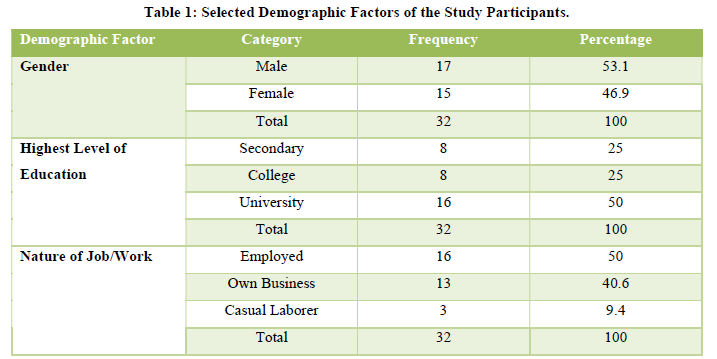

Selected Demographic Factors and Job-related Physical Activity
The aim of the study was to establish the relationship between the selected demographic factors and average time spent in physical activities for a period of one week (7 days). The World Health Organization (2018) stipulates that on average, adults should ensure at least 75 min of vigorous and 150 min of moderate physical Activity in a week, aiming to increase the levels gradually. In order to establish the relationship between selected gender and achievement of the recommended Physical Activity levels, data was collected among adults 40-50 years of age using IPAQ and results are tabulated as shown in Table 2.
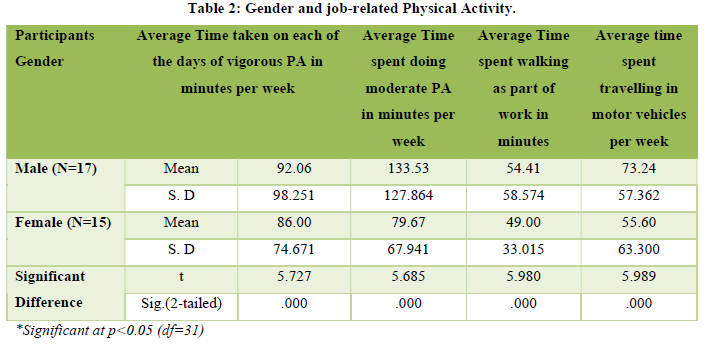

Time (in minutes) spent in job-related physical activities (PA) for a period of one week (7 days) among adults of 40 - 50 years of age were computed into means and paired samples test used to determine whether a statistically significant mean difference existed between gender. Table 2 above revealed on average, time taken in vigorous PA were higher in male 92.06 min compared to female at 86.00 with a statistical difference of t(31)=5.727; p= .000. On the contrary, time spent in moderate PA as part of work was higher in male 133.53 compared to female 79.67 with a statistical significance difference of t(31)=5.685 ; p=.000. Further, time spent walking remained higher in male 54.41 compared to female 49.00 and a significant difference of t(31)=5.980; p=.000. Similarly, time spent travelling in motor vehicles was higher in male 73.24 compared to female 55.60 with a statistical significant difference of t(31)=5.989, p=.000. This implies that male performed better than female counterparts in achieving the recommendations on average time spent in vigorous and moderate PA as well as walking as part of work. The results showed that walking as part of work had the lowest time which may likely hinder full benefits of work-related PA (Table 3).
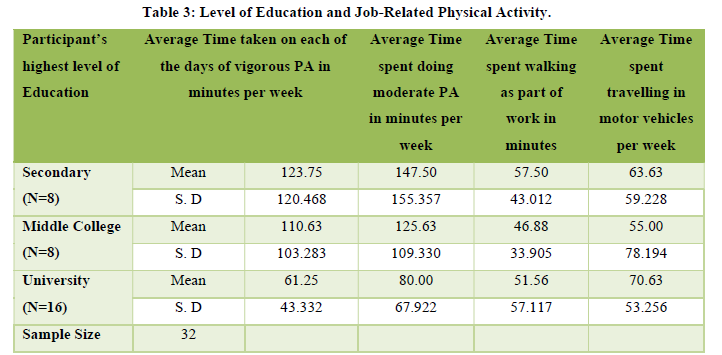

Education is linked to influence on the knowledge an individual’s have in relation to benefits of physical activity for health wellbeing. The study sought to find out if levels of education had any relationship with the amount of time spent in job-related physical activity. Average time (in minutes) spent in job-related physical activities (PA) for a period of one week (7 days) among adults of 40-50 years of age was computed into means groups across levels of education. Table 3 above revealed on average, time taken in vigorous PA per week were higher among participants whose level of education was Secondary school 123.75 min, followed by Middle-college education 110.63 and lower means for university level 61.25. A similar order was noticed in time spent in moderate PA as part of work per week, participants with Secondary school level of education topped at a mean of 147.50 min, Middle- college followed at 125.63 min and those with university level attained a mean of 80 min per week. Further, time spent walking had very close means whereby those with Secondary school level of education were slightly higher at 57.5 min, 46.88 for Middle -college level and 51.66 for those with university level. The average time spent travelling in motor vehicles was higher highest among participants with university education level 70.63 min per week, those with Secondary level followed at a mean of 63.63 min per week and those with middle-college education settling at a mean of 55.0 min per week. This implies that participants with Secondary level education topped in achieving the recommendations on the amount of physical activity requirements (Table 4).
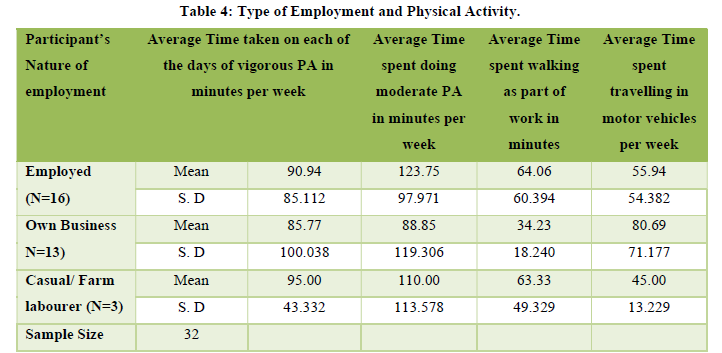

Type of occupation has been associated with excessive sitting among full time office workers and unorganized routines among non- fulltime office holders. Amount of time spent in physical activity vary across different occupations. Average time (in minutes) spent in vigorous physical activities (PA) within a week was computed in means across three types of employment. Results in Table 4 show that adults under casual /farm labourers recorded the highest (95 min) average time spent in vigorous physical activity followed by those who were employed (90.4 min) while those who owed business spent the lowest time (85.77 min). Employed adults spent the highest average time (123.75 min) in moderate physical activity compared to casual labourers (110.0 min) and those owning business spent the last time (88.85 min). Business owners spent the lowest (34.23 min) time walking as part of work while those employed and the casual labourers recorded higher close averages (64.06 and 63.33 min) respectively. Highest average time spent travelling in motor vehicles was recorded by adults who owned businesses (80.69 min) followed by those in employment (55.94 min) with those offering casual labour recorded the lowest (45.00 min). To test if there was a relationship between nature of work and jo-related physical activities, a Paired sample t-test was carried out. The results are shown in Table 5.
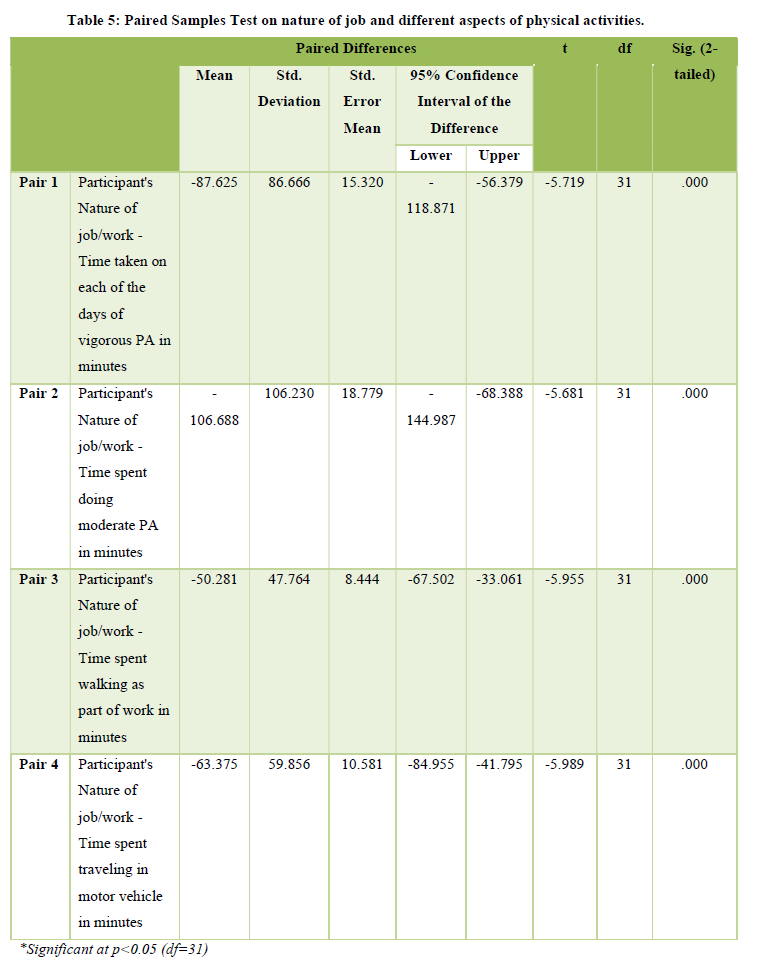

Paired sample t-test in Table 5 reveal statistical significance difference between nature of job and average time spent in various aspects of physical activity. Results indicate that the highest average time (106.688 min) was doing moderate physical activity with a statistical significance difference at t (31) = -5.681, p=0.000 followed by time (87.625 min) spent in vigorous physical activity with a statistical significance difference at t (31) = -5.719, p=0.000, average time spent (63.375 min travelling in motor vehicles with a statistical significance difference at t (31) = -5.989, p=0.000 and the lowest average time (50.281 min) spent in walking as part of work with a statistical significance difference at t (31) = -5.955, p=0.000. This implied that although all had significance differences the mean reveals that despite the nature of participants job moderate physical activity was evident.
DISCUSSIONS
Findings of this study established amount of time spent by adults of age 40 to 50 years in job-related physical activity the interrelatedness with selected demographic factors (gender, level of education and nature of job) of the study cohort.
Gender and Job-related physical activity
It was evident from the results that all study participants spent a considerable amount of time in job- related physical activity. Both genders attained the recommended 75 min of vigorous physical activity per week at 92.06 min among male and 86.00 min for female. The recommended time per week for moderate physical activity is 150 min and only male participants nearly achieved the parameter at 133.53 min. This in agreement with studies by (Michishita et al, 2017). (Puciato, 2019) showed that generally men spent more time in different forms of work-related physical activities. In addition, the findings showed a statistical significance difference between male and female t (31) =5.685; p=.000.
Level of education and time spent job-related physical activity
All participants spent surmountable time in job - related physical activity irrespective of their education levels. However, study participants with secondary level recorded the highest amount of time spent in both vigorous and moderate physical activity at 123.75 and 147.50 min respectively. Participants who had attained University education spent the least amount of time both vigorous 61.25 and 80.00 in moderate physical activity agreeing with the study by (Gemna, 2020). on office workers being associated spending more sedentary time in offices. It was clear that the higher levels of education did not influence time spent in job-related physical activity similar with (Scholes & Bann, 2018) whose study findings revealed that education is not a determinant of exercise participated in.
Type of employment and job-related physical activity
The study findings revealed that participants who run their own businesses recorded the highest average time spent in vigorous physical activity per week at 100.03 min although none attained the recommended 150 min in moderate physical activity concurring with (Casey et al, 2018).
CONCLUSIONS
The current concludes that adults aged 40 to 50 years indeed spend in job-related physical activities. It was evident that gender and nature of employment influence amount of time spent in a week in moderate to vigorous physical activities and less time spent walking as part of work across the selected demographic factors of the study participants. There is need to reemphasize benefits of job-related physical activity in alleviating life-threatening conditions emanating from sedentary behavior at work place. It is recommended that adults aged 40 to 50 years to identify strategies that would help in achieving the 150 min of physical activity per week. The study depended on participants recalling time spent in the parameters of the IPAQ thus recommending further study using physical activity monitors.
- Casey, M.L, Srinivansan, K, Brian G, Javad R, Hyoki L, et al. (2018). Effects of Office Workstation Type on Physical Activity and Stress. BMJ Journal of Occupational and Environmental Medicine 75(10): 689-695.
- Daniel, P. (2019). Sociodemographic Association of Physical Activity in People of Working Age. International Journal of Environmental Research and Public Health 16(12): 2134.
- Friedman (2014). Regular Exercise is Part of Your Job Harvard Business Review.
- Gemna, C.R, Patricia, A., Maritne, S., Trish, G., & Josie, M.M. (2020). Physical Activity in Paid Work Time for Desk based Employees a Qualitative Study of Employers and Employees. Journal of BMC Public Health 20: 460.
- Landi, F., Calvani, R., Picca, A., Tosato, M., Martone, A.M., et al. (2018) Impact of habitual physical activity and type of exercise on physical performance across ages in community living people. PLoS One 13(1): e0191820.
- Michishita, R., Jiang, Y., Ariyoshi, D., Yoshida, M., Moriyama, H., et al. (2017). The introduction of an active rest program by workplace units improved the workplace vigor and presenteeism among workers. Journal of Occupational and Environmental Medicine 59: 1140-1147.
- Robi, L. (2016). Embrace an Ageless Mindset reenergize your Dreams and Live a Soul Satisfying Life. HarperCollins Publishers New York.
- Rhiannon, L.W., Jason, B., Gavin, A., & Meghan, T. (2020). Work related physical activity and psychological distress among women in different occupations a cross sectional study. BMC Public Health 20: 1007.
- Scholes, S., & Bann, D. (2018). Education related Disparities in reported Physical Activity during Leisure time active transportation and Work among US adults repeated Cross-sectional Analysis from the National Health and Nutrition Examination Surveys. BMC Public Health 18: 926.
- World Health Organization (2020). Guidelines on Physical Activity and Sedentary Behavior. Retrieved from: http://orcid.org/0000-0001-8035-4973


